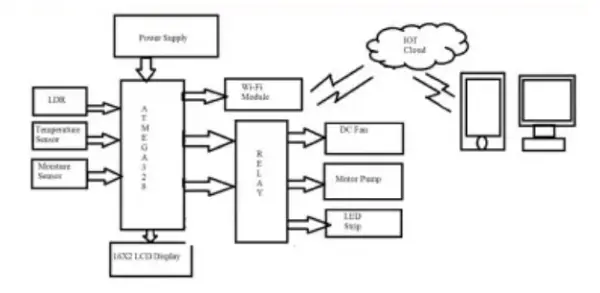INTRODUCTION
A greenhouse serves as an environment that can alter the growth conditions for plants, creating optimal settings while shielding them from external variations in seasons and weather. Within the greenhouse, various parameters, such as temperature and humidity, need careful monitoring. Human oversight of these parameters is challenging, and any significant change in one climate factor can adversely affect others and impede plant development.
Our initiative involves creating a framework to automate the provision of water to plants based on their specific needs and the current moisture levels in the soil [2]. This approach addresses the difficulties associated with manual monitoring. Continuous supervision and control of climate factors within the greenhouse are essential for maximizing crop yield, enhancing quality, regulating growth periods, and improving overall economic efficiency. The obtained results indicate the system’s reliability, successfully overcoming several drawbacks of existing systems while offering flexibility and precision in maintaining the environmental conditions.
As technology advances, global entities like the Food and Agriculture Organization (FAO) are urging farmers to adopt innovative tools and digital technologies [3]. The primary objective of this project is to minimize the prohibitive hardware costs, making the system more accessible to small-scale farmers.
1.1 BACKGROUND
1.2 PROBLEM STATEMENT
Developing an Android-based automated application for warehouse management involves the collection, monitoring, maintenance, and calculation of results using various sensor devices. The system efficiently covers a large area due to the utilization of microcontrollers. To address this challenge, we propose the implementation of a greenhouse automation system employing IoT technology and a dedicated software application. This integrated solution will actively monitor, analyze, make informed decisions, and control the irrigation system to ensure optimal environmental conditions within the greenhouse.
2. LITERATURE SURVEY
2.1 Smart Irrigation for Vegetable Traceability through Internet of Things
This paper introduces an intelligent wireless sensor network designed for monitoring agricultural settings. The primary emphasis is on overseeing the soil moisture, humidity, water supply control, and temperature within a specific farmland. The sensors employed for these purposes include soil moisture, humidity, water level, and temperature sensors. Information gathered from these sensors is transmitted to a microcontroller, which then displays the data through a dedicated application.
2.2 Automated Irrigation System Research – IoT-based Approach
Improving water management can be achieved through an automated irrigation system. This paper suggests an automated irrigation framework designed for agricultural lands, aiming to reduce manual labor and optimize water usage to enhance crop productivity. The setup utilizes an Arduino kit with a moisture sensor and a Wi-Fi module. Our experimental configuration is linked to a cloud framework for data acquisition. Subsequently, the collected data undergoes analysis through cloud services, leading to the provision of appropriate recommendations.
2.3 IoT Sensor Network Strategy for Enhanced Farming
This study introduces an algorithm grounded on predefined temperature and soil moisture thresholds, integrated into a programmable microcontroller for the purpose of regulating irrigation schedules. The system’s power requirements are sustainably met through a solar Photovoltaic (PV) panel, complemented by an energy storage unit. Experimental data derived from the prototype will be modeled and optimized to analyze the food production profile in relation to energy and water consumption. Additionally, the research aims to examine the impact of extreme weather conditions on food production. This comprehensive approach delves into the interconnected relationship among water and energy resources, and crop yield, with the objective of designing a more sustainable approach to meet the anticipated surge in demand.
2.4
The Internet of Things (IoT) refers to the interconnection of various devices through the internet. This paper discusses a proposed IoT-based system utilizing real-time input data for smart farm irrigation management. The system employs wireless sensor networks and Zigbee communication to facilitate remote monitoring and control of drips, utilizing an Android phone. Real-time data handling and presentation on the server are executed through a web-based Java graphical user interface. The wireless monitoring of the field irrigation system diminishes human intervention, enabling remote control through an Android phone. Additionally, the paper proposes and evaluates a cloud-based wireless communication system to manage a set of sensors and actuators, assessing the water needs of plants.
3. SYSTEM DESIGN

The practical implementation commences with the initialization phase, involving the setup of all hardware components. Each sensor is assigned a specific threshold value, encompassing temperature, light, moisture, and gas sensors to assess the greenhouse environment. The maintenance of the greenhouse environment is achieved by adhering to these threshold values. Subsequently, these recorded values are uploaded to the cloud, allowing for detailed monitoring through a mobile application. The greenhouse atmosphere is regulated using fans, lights, and sprinklers, which can be monitored both manually and through the mobile application.
The integration of Wireless Sensor Networks (WSNs) with Cloud Computing is elucidated, offering a performance comparison guideline. This integration aims to enhance overall system performance and address the storage and energy constraints of WSN [4].
4. CONCLUSIONS
An Android application is utilized for monitoring and controlling activities within the agriculture field at the user’s end. This application is user-friendly, easily programmable, installable, and lightweight. It fulfills all the requirements for warehouse automation and is readily accessible on Android systems, making it suitable for large areas. The utilization of microcontrollers in the system helps in minimizing hardware costs.
